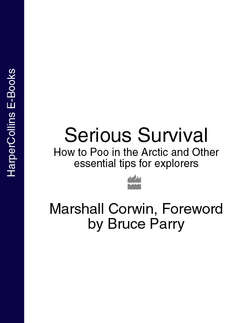Читать книгу Serious Survival: How to Poo in the Arctic and Other essential tips for explorers - Bruce Parry - Страница 11
ОглавлениеSerious Arctic
THE POLAR REGIONS
All extreme environments are unforgiving, but some are definitely more unforgiving than others. Many would say the Arctic and Antarctic are the most hostile regions of all to humans – rivalled only by the freezing conditions at the top of the world’s highest peaks. Here the tiniest mistake can have catastrophic consequences. Even spilling a little water on yourself can set off a chain of events which may lead to death (see page).
Imagine living inside a freezer for weeks on end, then think way, way colder and you start to get some idea of typical polar conditions (average freezer: –18°C/–0.4°F; average Arctic winter’s day: –30°C/–22°F).
On first arrival in the region many adventurers suffer ‘Arctic Shock’, a state of near panic where their body urgently tells them it doesn’t appreciate such crazy temperatures. All they can think of is getting back into the warmth as quickly as possible.
The secret is to adopt a completely different mindset. Everything has to be adjusted to the fact that you’re boldly going where humans were never designed to be (apart from the native peoples – see Inuit Survival, page). Things that take a few seconds back in ‘civilisation’, such as getting into bed, may well need a good half hour in the freezing conditions.
The rewards are great, and not just the huge satisfaction of joining an elite band who’ve ‘been there, done that’ and lived to tell the tale. The Arctic and Antarctic are breathtakingly beautiful. Whether it’s the extraordinary ice sculptures formed by the wind and the sea, or the spectacular Northern and Southern Lights, the polar regions have an unearthly, almost spiritual appeal.
TO THE ENDS OF THE EARTH
The first explorers to take on the North and South Poles were phenomenal pioneers, heading into some of the harshest conditions on Earth without any of the safety nets modern adventurers take for granted, such as GPS satellite navigation devices and satellite phones to call in assistance.
The famous race for the South Pole in 1911 saw the Norwegian team headed by Roald Amundsen triumph over their British rivals led by Captain Robert Scott. The British team did reach the Pole just over a month after the Norwegians, but tragically all died on their return journey.
The American Robert Peary is often credited as being the first to get to the North Pole, in 1909, but this is disputed. An American team made it in 1968, using snowmobiles, while the first confirmed non-mechanized conquest was made by a British team in 1969.
ARCTIC V ANTARCTIC
The two polar regions on the planet share much in common. They do, however, have some significant differences (see below).
| ARCTIC | ANTARCTIC |
| Made up of the Arctic Ocean (much of it frozen) surrounded by the northernmost parts of several countries including the USA (Alaska), Canada, Greenland, Norway and Russia. | A huge continent covered in ice. No country owns Antarctica. |
| The North Pole is located in an area of frozen sea ice that constantly drifts and breaks up. Adventurers find it hard to stay precisely at the Pole as the ice sheets shift beneath their feet. | The South Pole is located pretty well in the middle of the Antarctic land mass, at an altitude of almost 3,000m (10,000ft). A ceremonial pole and flag has been planted at the South Pole and there is a permanent scientific research station nearby. |
| Inhabited sparsely by indigenous peoples. | Has no native peoples. |
| The kingdom of the polar bear, plus other mammals including caribou and foxes. (But absolutely no penguins!) | The kingdom of the penguin.Has no land-based mammals at all. |
THE LAND OF THE MIDNIGHT SUN
The Arctic Circle is a special line of latitude at around 66°N. It marks the furthest distance from the North Pole where each year you get at least one full 24-hour day when the sun doesn’t set, and one full day of complete darkness. As you get nearer to the Pole there are more and more summer days when the sun doesn’t set, and more winter days when the sun never rises. At the Pole itself you get six months of daylight followed by six months of darkness.
The same properties apply to the Antarctic Circle at 66°S, though with the seasons reversed.
THE NORTHERN AND SOUTHERN LIGHTS
Also known as the Aurora Borealis and Aurora Australis, the Northern and Southern Lights are shimmering, ever-changing curtains of light in the night sky, caused by radiation from the sun hitting the Earth’s magnetic field near the Poles.
© Matthias Breiter/Minden Pictures/FLPA
